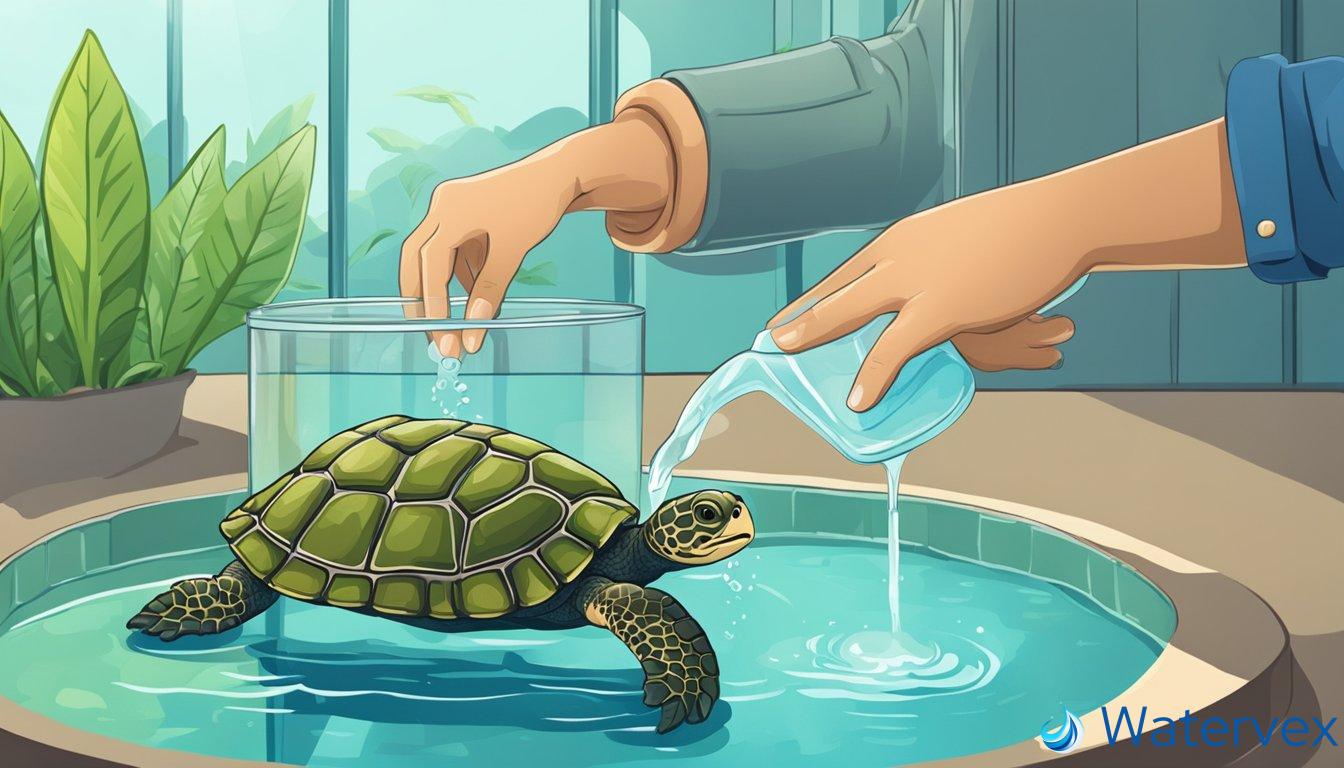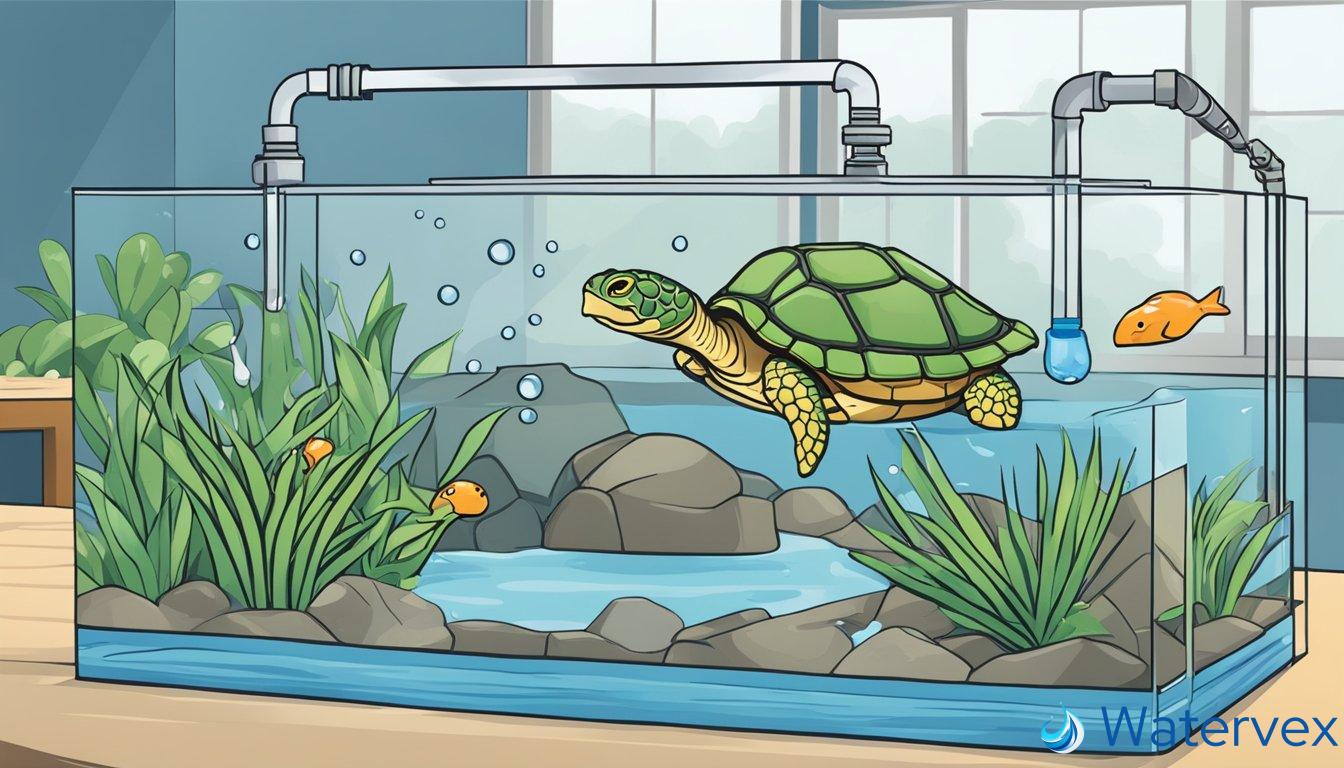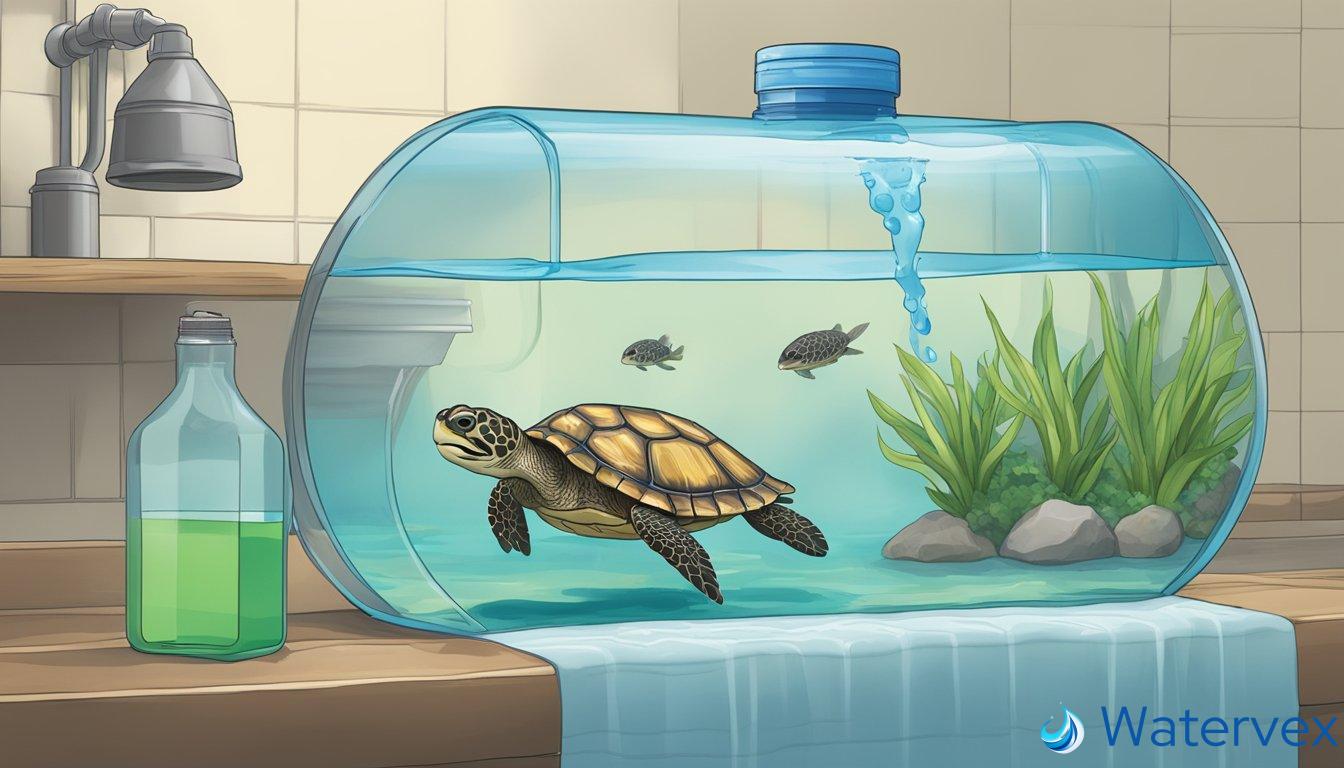When it comes to maintaining a healthy habitat for aquatic turtles, ensuring safe and clean tank water is a crucial task. Tap water often contains chemicals like chlorine and chloramines, which can harm your turtles. This is where water conditioners come into play: they neutralize these harmful chemicals, making the water safe for your turtle’s delicate system. But it’s not just a matter of adding water conditioner to the tank; there’s a proper method to ensure the safety and wellbeing of your turtles.

Understanding the science behind water conditioners is essential for any turtle owner. The water you pour into the tank straight from the tap isn’t immediately suitable for your aquatic friends. Water conditioners work by detoxifying harmful substances from the water. By following accurate measurements and procedures, you directly contribute to creating an environment where your turtles can thrive. Regular use of a water conditioner as part of your water maintenance routine is necessary to maintain optimal water quality over time.
Key Takeaways
- Water conditioners are essential for neutralizing harmful chemicals in turtle tanks.
- Accurate and consistent application ensures a safe habitat for aquatic turtles.
- Routine use is crucial to maintain water quality and turtle health.
Why Should You Use a Water Conditioner for Your Turtle’s Habitat?
Water conditioners are crucial for maintaining a safe environment in your turtle’s habitat. Chlorine and chloramine are chemicals commonly found in tap water that can pose serious health risks to your turtle, while a proper water conditioner can neutralize these risks effectively.
Benefits of a Water Conditioner for Turtle Health
Using a water conditioner provides a safer living environment for your turtle by removing harmful chemicals. Tap water may contain chlorine or chloramine, which are added to prevent bacterial growth but can adversely affect your turtle’s eyes and skin, and even lead to stress. Conditioners dechlorinate the water, making it safer for your pet.
Conditioners also play a role in balancing the pH levels in the aquarium, which is critical for the health and well-being of your turtle. Unbalanced pH can cause stress and harm the beneficial bacteria necessary for a clean habitat.
Furthermore, many water conditioners help to neutralize ammonia, a harmful byproduct of waste that can accumulate in the tank. Conditioners also bind heavy metals, preventing potential toxicity.
Besides eliminating health risks, a conditioned environment helps promote the growth of beneficial bacteria — these bacteria are vital for breaking down waste, maintaining a clean habitat, and supporting the biological filtration system in your turtle’s aquarium.
Differences Between Turtle and Fish Water Conditioners
While both turtle and fish water conditioners aim to dechlorinate water and remove chemicals, formulations may differ to cater to specific needs. Turtle-specific conditioners often take into account the less sensitive nature of turtles compared to fish but still focus on eliminating substances that can irritate or harm turtles.
It’s important to understand that fish water conditioners can sometimes be used for turtles, as they also remove chlorine and chloramine, but confirm the suitability for turtle use. Always check that the conditioner you’re considering does not harm the bacteria crucial for the aquarium’s ecological balance.
Remember, a dedicated turtle conditioner is formulated considering the unique biology of turtles, ensuring the elimination of chemicals that could lead to stress or harm, while maintaining an environment where bacteria can thrive and support a healthy ecosystem.
What Steps Are Involved in Properly Conditioning Turtle Tank Water?

Proper water conditioning is crucial for the health of your turtle. Below you’ll find specific steps to prepare water using conditioner, and how to maintain optimal water quality over time.
Preparing the Water with Conditioner
To begin, use a water conditioner that neutralizes harmful chemicals such as chlorine, chloramine, copper, and other heavy metals found in tap water. Measure the conditioner accurately according to the gallon capacity of your turtle tank to avoid disrupting the water parameters.
- Dechlorinate: Add the water conditioner to the tank water as directed on the product label to eliminate chlorine and chloramine, which can cause diseases in turtles.
- Neutralize Metals: The conditioner should also detoxify harmful metals like copper, which at high levels can be toxic to turtles.
- Set Temperature: Ensure the water temperature is consistent with the needs of your species of turtle, as improper temperatures can lead to stress and health issues.
- Check pH Levels: Before introducing your turtle, check that the pH levels are within an acceptable range for turtle habitation, which is typically between 6.0 and 8.0.
Regular Maintenance and Water Quality Checks
After the initial set up, maintaining high water quality is imperative. Regular checks and adjustments ensure a safe habitat for your turtle.
- Test Water Parameters: Use test kits to monitor levels of nitrite, nitrate, and pH regularly. Aim to keep nitrite and nitrate levels low as they can indicate deteriorating water quality.
- Use Filters: Install a robust filtration system, ideally rate it higher than your tank’s capacity, to handle waste and maintain clarity. Filters are key to managing ammonia levels, stemming from turtle waste, which can transform into harmful nitrate if not adequately controlled.
- Change Water: Conduct partial water changes weekly, replacing 25% of the tank water to remove waste buildup and replenish the tank with fresh, conditioned water.
- Track Temperature: Keep a thermometer submerged to monitor the water temperature, ensuring it remains within the ideal range for your pet.
Remember, your turtle’s well-being depends on a clean and well-regulated environment, and consistent use of a water conditioner alongside diligent water quality management is the backbone of healthy turtle tank maintenance.
How Often Should You Treat Your Turtle’s Water With Conditioner?

Ensuring the health and well-being of your aquatic turtle requires regular water treatment with a safe, specifically-formulated turtle water conditioner. This not only neutralizes harmful chemicals like chlorine and chloramines but also prevents the buildup of toxic substances that can jeopardize your turtle’s health.
Scheduling Water Treatments for Optimal Health
When it comes to scheduling water treatments, a good rule of thumb is to treat the water with a conditioner every time you change the water or add tap water to the tank. Generally, water changes are done weekly, but you should always follow the recommended dosage and directions on the turtle water conditioner bottle. It’s crucial to neutralize harmful chemicals every time you introduce new water to keep conditions safe and consistent for your turtle.
- After Water Changes: Immediately add conditioner following the guidelines on the packaging.
- When Topping Off: If you’re just adding a little water to make up for evaporation, still treat that water with conditioner.
- Monitor Water Quality: Regularly test the water; if harmful chemicals are detected, treat accordingly.
To maintain an inexpensive yet safe environment, consider the size of your tank and the condition of your tap water. Some owners opt for bottled water as it may require less treatment, but for many, using a conditioner in tap water is more cost-effective.
Remember, a veterinarian specializing in reptiles can offer advice specific to your situation, so if in doubt, do not hesitate to consult one. By keeping these practices in mind, you, as a responsible turtle owner, will greatly contribute to your aquatic friend’s well-being while mitigating any potential risks associated with untreated tap water.

